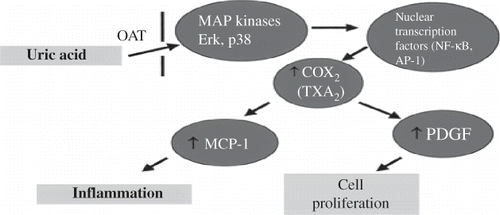Figures & data
Table 1. Major pathophysiological mechanisms of uric acid-induced damage.
Figure 1. Pathways by which uric acid induces proliferative and inflammatory mechanisms. Uric acid enters vascular smooth muscle cells through specific OAT and activates intracellular MAP kinases, p38 and Erk 1/2, and nuclear transcription factors (NF-κB and AP-1), leading these cells to acquire a proliferative and inflammatory phenotype. Thus, vascular smooth muscle cells, through increased expression of COX-2 and TXA2, produce cytokines, growth factors (PDGF), and proinflammatory molecules (MCP-1).
Note: OAT, organic anion transporter; MAP, mitogen-activated protein; NF-κB, nuclear factor kappa B; AP-1, activator protein-1; COX-2, cyclooxygenase-2; TXA2, thromboxane; PDGF, platelet-derived growth factor; MCP-1, monocyte chemoattractant protein-1.

